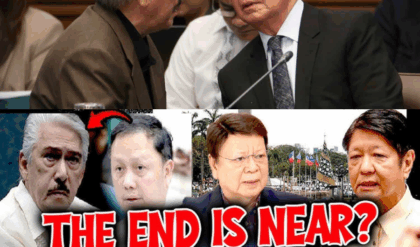In the high-stakes world of Philippine politics, a single revelation can shake entire institutions. Last week, the political arena erupted after the release of the so-called “Saldiko” confession, a video in which a fugitive lawmaker claimed that massive, unauthorized insertions were being funneled through the national budget, implicating top officials in what appeared to be systemic corruption. But as the nation grappled with the shock, a new narrative quietly began to emerge—one that threatened to blur the lines between accuser and accused, heroes and hypocrites.
The “Saldiko” video was explosive, painting a vivid picture of manipulation and deceit. It depicted a lawmaker set up as a scapegoat while billions were allegedly redirected through carefully orchestrated budget insertions. Social media platforms and political vlogs were immediately ablaze, dissecting every frame, every claim. Yet what initially seemed like a direct attack on the current administration quickly morphed into a broader struggle for legitimacy.
Almost immediately, commentators began to pivot the conversation toward former senators Panfilo “Ping” Lacson and Vicente “Tito” Sotto III, two of the most influential figures in Philippine politics. The accusation: they had long practiced the same type of budget manipulations that Saldiko exposed, undermining their longstanding reputations as anti-corruption watchdogs. A mysterious insider, described only as a “Senate staffer,” allegedly confirmed that during their time in office, both senators routinely inserted billions into favored projects—projects that critics now describe as indistinguishable from pork-barrel allocations.
For Lacson, this is a particularly jarring blow. The senator’s political identity has long rested on his reputation as a meticulous guardian of the national budget—a man who prided himself on exposing waste and defending transparency. To have those same methods attributed to him casts a shadow over decades of public service and raises uncomfortable questions: if Lacson perfected this system, was his moral authority ever genuine? And if Sotto participated alongside him, can any public figure claim to have been immune to these practices?
Meanwhile, the story of “Zaldy Co,” the current House Appropriations chair rumored to be the operator of today’s insertion schemes, adds a contemporary layer to this political drama. Observers suggest that Co is essentially the latest steward of a system perfected by his predecessors. This framing effectively shifts the debate from isolated wrongdoing to a question of systemic rot: corruption, it seems, is less about individuals and more about institutions.
Political analysts point out that this narrative strategy—accusing the critics of past complicity—is a classic form of “whataboutism.” It transforms the discussion from, “Is the current government corrupt?” into, “Have these figures ever been uncorrupt?” In one swift move, the moral high ground is contested, and public outrage is reframed. In effect, the past is weaponized to protect the present, and every accusation carries an echo of counter-accusation.
The unnamed Senate staffer is central to this maneuver. Though their identity and credibility remain unverified, their claims are being treated as evidence of institutional hypocrisy. According to the reports, this insider outlined how amendments—ostensibly intended for public programs—were inserted into the national budget during the bicameral conference stage, often without public disclosure. The alleged practices mirror those Saldiko described, reinforcing the idea that the current crisis is merely the latest chapter in a long-standing pattern.

At the heart of the controversy is the question of definitions. What constitutes a legitimate budget amendment versus a self-serving insertion? Lacson maintains that his amendments were programmatic, designed to address gaps overlooked by the executive branch—national defense, disaster preparedness, or infrastructure. Yet critics insist these distinctions are semantic, claiming that the real effect was the channeling of billions into projects with selective beneficiaries. The debate is not merely political; it strikes at the ethics of governance itself.
For the public, the unfolding drama is dizzying. Between Saldiko’s confession, the alleged insider revelations, and a torrent of social media analysis, the lines between truth, deception, and strategic framing blur. Some commentators argue that both Saldiko and the supposed staffer may be partially accurate, reflecting different perspectives on a system that has long operated with opacity. Others view it as pure theater, a power struggle in which narratives are weapons and the audience is left to navigate a hall of mirrors.
Regardless of where the truth lies, one consequence is clear: the system of insertions—once shrouded in secrecy—has been exposed as both persistent and pervasive. This raises uncomfortable questions not only about those in power now, but also about the politicians who built and maintained these networks over decades. The story is no longer about one lawmaker’s misdeeds; it is about how political structures allow, and perhaps even encourage, such behavior.
As the debate intensifies, public trust faces unprecedented strain. Citizens are forced to wonder whether accountability is possible in a system where former critics may have played the same game, and where today’s whistleblowers are also participants in the intricate machinery of budget allocation. The drama surrounding Lacson, Sotto, Zaldy Co, and the shadowy staffer is less a scandal about a single figure than a reflection of an entire governance ecosystem—one where the line between hero and opportunist is perilously thin.
Ultimately, this saga exposes a bitter reality: in Philippine politics, the real power may not lie with those wielding moral authority or legislative influence, but with the system itself. Whichever lawmaker holds the pen at a given moment has the ability to shape billions in public funds. And in this high-stakes game, confessions, allegations, and counter-accusations are not anomalies—they are part of the routine, a reflection of a system where transparency is contested and accountability is a moving target.
As the nation watches, the public is left with a pressing question: are we witnessing a fight for justice, or a spectacle of old rivals settling scores over the spoils of a system that has long governed itself beyond scrutiny? Perhaps the ultimate revelation is not the guilt of a few individuals, but the enduring power—and opacity—of the political machine itself.


